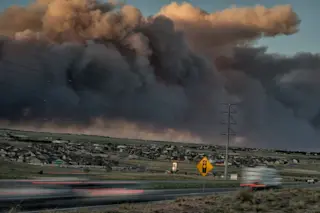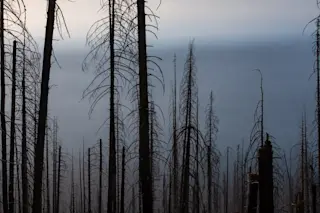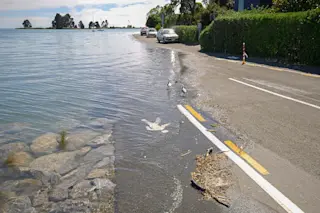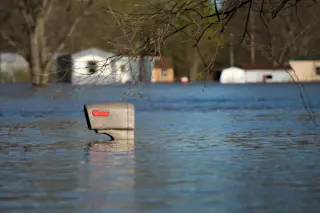The Black Forest Fire, seen in this photo by Chris Carruth, erupted north of Colorado Springs on June 11. Burning in an area where fire-prone forest and housing were intermixed, it went on to kill two people and destroy 486 homes before it was contained on June 20th. (Photo: © Chris Carruth) Sometimes statistics lie: Both the number of U.S. wildfires and acreage burned since Jan. 1 are trending well below the 10-year average. Those numbers are true, but they also lie because they don't tell the full story — which also includes 19 firefighters killed in Arizona's Yarnell Hill Fire, and two people dead plus 486 homes destroyed in Colorado's Black Forest Fire. That second set of statistics should jolt us into seeing things in a new light. And I'm hoping that the Q&A below by Christi Turner will help shine that light on a key issue raised by the human suffering we've already experienced this wildfire season: development in the fire-prone wildland-urban interface, or WUI. Turner is a talented graduate student in the environmental journalism program I direct at the University of Colorado. (Click here for her photography portfolio, which includes spectacular imagery of Madagascar.) Her interview with Ray Rasker, Executive Director of Headwaters Economics, appeared first in The Boulder Stand, an online environmental magazine published by our students. If you want to hear some practical ideas for taming wildfire risks, limiting development in the most fire-prone areas, and reining in the skyrocketing costs of fighting wildfires, I urge you to keep reading. Also, please check out Headwaters Economics for detailed, in-depth information, including their recent report on the rising cost of wildfire protection.
Based on your research, what’s behind the increase in Western wildfires in recent years? The forces are of course climate change, as well as past forest practices. We also have more insect infestation. It can get very complicated. But you’ve got fuel, you’ve got climate change and you’ve got homes. As we say, it’s the three W’s: weather, wood and WUI – the wildland-urban interface. Our area of expertise is really on the latter. If you look at the big picture across the West, the acreage burned in the last decade has doubled in size. They also burn twice as long. And the season is starting earlier and ending later. In California, we were looking at recent fires in the Sierra Nevada and we found that when it’s 1 degree Fahrenheit warmer in the summertime, the average acres burned increases by 35 percent. But is it temperature alone? Or is it that with warmer temperatures you get more desiccation? Is it the fact that the pattern of rainfall has changed and we’re getting more spring flooding but less rain in the late summer, so that you get drought at the end of the summer and that leads to more forest fires? How has this translated into increasing costs related to wildfire? The federal appropriations and Forest Service and BLM (Bureau of Land Management) for wildland firefighting has gone from about $1 billion a year on average during the 1990s, to now on average over $3 billion per year. So the cost has tripled. And we’re trying to determine what percentage of that cost is attributable to the building of homes on fire-prone lands. The Forest Service estimates that anywhere from 50 to 95 percent of total firefighting costs are related to homes. Our estimates are more on the order of about 30 percent. Either way, it’s significant. If it’s 30 percent it would be about $1 billion a year.
Q&A With Western Wildfire Expert Ray Rasker, Director of Headwaters Economics
By Christi Turner

Click on this thumbnail for a map of the wildland-urban interface. (Map: EcoWest) The most remarkable fact behind all this is if you look at the wildland-urban interface, which is private land adjacent to forested federal land, only 16 percent of that is developed right now. So 84 percent of that is wide open for further development. And the conversation around fire is really focused on that 16 percent – you have things like FireWise education teaching people how to increase their chances of surviving the fire – but that says nothing about future development. And we really haven’t had this national conversation yet about that as-of-yet undeveloped land, and what we can do to influence the pace and the pattern and the scale of future development. Are there any examples of this conversation happening on a state or local level? In some places at the local level, there’s been some work to restrict development based on fire danger and safety. You can find those examples, but you can count them on one hand. For the most part, nobody seems to have any interest in restricting future development. And what’s worse, what we’re doing with educational efforts is that we’re telling people that it’s okay to continue to build on fire-prone land, just to use different building materials and create defensible space. At its worst we’re enabling further development. And the conversation nobody seems to want to have is: do we want to continue to build in dangerous places? So really the question is, why isn’t that conversation happening? Here’s the reason why that conversation’s not taking place: the bulk of the firefighting costs are paid for by the federal taxpayer and not at the local level, where the land use decisions are being made. So FEMA (Federal Emergency Management Agency), the Forest Service, BLM – they pay the bulk of the firefighting costs. So when a county commissioner is looking at a new subdivision or a new plan for new homes, one of the things they should think about is whether they can afford their share of the firefighting costs. But that’s not part of the calculus right now. If it were, it would drastically change the pattern of development in the future. So there are two conversations: one is, what do you do with that 16 percent of the Wildland-Urban Interface that’s developed? And there the right approach is firefighting, landowner education, forest education, all of those things. And the other conversation is what do you do with that 84 percent that’s not yet developed? You don’t find people thinking about restricting future developments. What do you think it’s going to take to get that conversation started?
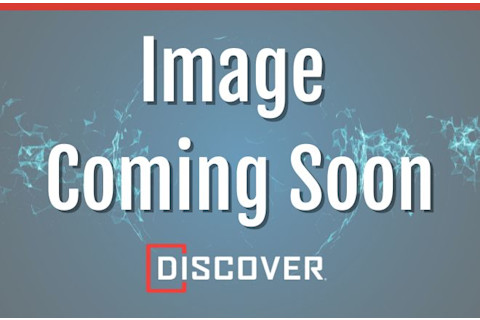
Click thumbnail for a map of Arizona's wildland-urban interface. (Map: SILVIS Lab, Univ. of Wisconsin) Safety is certainly, hopefully a tipping point. We’re looking at the Yarnell Fire and wondering if people are starting to pay attention to that. Cost is a big one. Congress is trying to tighten its belt on all fronts, yet firefighting is something where they’ve tripled the amount of money they’ve thrown at it. So at a certain point there’s not going to be enough money – there isn’t enough money for the thinning and restoration work that needs to be done. There’s about 230 million acres in need of some sort of treatment, whether it’s through prescribed burn or mechanical treatment, and they’re only able to treat about 3 million acres per year out of that 230 million. There just isn’t enough money to thin our way out of this problem. Do you have any potential solutions to address the issue? What we proposed in 2009 was a list of ten ways that you could shift the cost responsibility from the federal taxpayer down to the local level in a way that would change future firefighting costs. And we started with very innocuous baby-step ideas, such as mapping. Let’s map where the most dangerous places are, so that homeowners and developers and local governments know when they’re placing homes at risk. That happens from state to state in a very erratic way. So do we do as was done with floodplain mapping, where you make it a FEMA responsibility and it happens in a uniform way nationwide? The FEMA floodplains maps are out of date and there are all sorts of problems – but is there some sort of way, some requirement at the federal level, requiring mapping so that everyone knows where the most dangerous places are? One of the elements of floodplain legislation is that if you want to borrow money for a house, if you’re going through an FDIC-insured lender, one of the pieces of paper you have to sign is that you’re not in the floodplain. And if you are in the floodplain, you don’t qualify for a loan. Can we borrow something from that legislation and use that at the federal level to restrict where people build homes in the most dangerous places? The Land and Water Conservation Fund – there’s pockets of money like that available for the purchase of land if it has conservation value. Why not add to the criteria dangerous or fire-prone land? We’re getting to a point where in some places it’s cheaper to just buy the land than it is to defend the homes from wildfire. In some of the fires in the Sierras of California, for example, it cost $400,000 to $600,000 per home to defend them from wildfire. There’s also something called a cost-share agreement, which is an agreement whereby the local government agrees to share the firefighting costs with the federal agencies. A lot of these cost-share agreements are signed on the hood of the truck as the fire is burning. There isn’t much of an incentive for county commissioners to sign these agreements ahead of time. Can we incentivize them to sign? In other words, they get more land-use planning assistance, they get more federal grants, if they sign a cost-share agreement ahead of time. And conversely if they don’t sign a cost-share agreement then we withhold federal payments. And then you have the default option – which we may get to – which is just to reduce the federal firefighting budget, with the feds eventually sending the bill to the states, and the states eventually sending the bill down to the counties. But the end result, you’ve got county commissioners staring at the reality that they may have to pay a higher share of the firefighting costs. That might buy the county commissioners the political cover they need to ask a developer to redesign a subdivision so that the homes are in the safest place possible. What about the role of insurance companies? Insurance policies don’t currently create incentives for folks not to build or rebuild on fire-prone land.

Click thumbnail for a map of the wildland-urban interface along Colorado's Front Range. (Map: EcoWest) Insurance is based on risk, and I think for a lot of insurance companies this isn’t yet a big deal. Hailstorms are a bigger deal. The Fourmile Canyon Fire was what, about $250,000 million in damages? The year before, there was a hailstorm with over $1 billion dollars in damages. If you think of a hurricane, or tornado – those are really expensive catastrophes, and fires don’t come close yet. That’s what I’m hearing from the insurance companies. It may also be that in some states, in California for example, it’s difficult to charge differential rates based on risk. But even if they could, we have to question whether that’s the right solution. Would that raise the rates enough to dissuade people from building in those places? I doubt it. There isn’t a silver bullet. Obviously insurance is going to be part of the solution, but not the only solution. You said you’d be hosting a conference this fall to refine some of these potential solutions into concrete propositions. What will that conference look like? What we’re looking for are people who want to talk about that 84 percent [of land in the WUI] that’s not yet developed, and people who have good ideas for how to direct the pace and pattern and scale of future development away from the most dangerous places. How do we actually make that happen? Is it federal legislation, is it state legislation, is it a series of incentives or disincentives, is it eliminating some subsidies, is it all of the above? What we’re hoping for as an outcome is a white paper with two or three highly-refined ideas for solutions. We really need to have a mature conversation as a nation about how we prevent further loss of life and loss of property by avoiding the most dangerous places, and just not building there.


